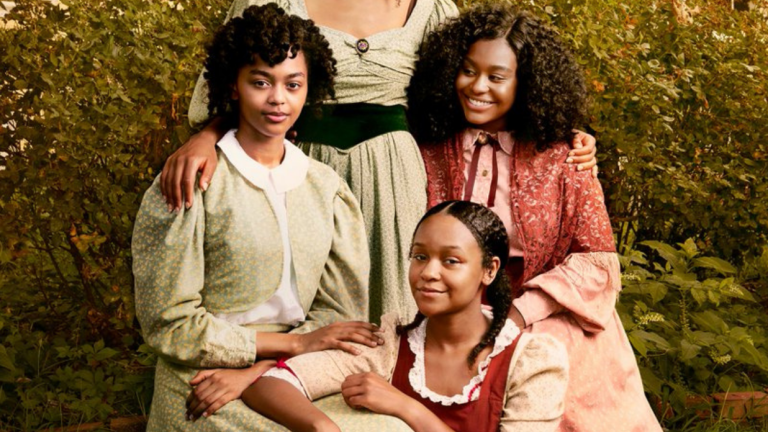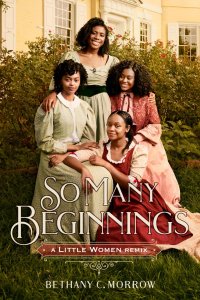Little Women Remixed: So Many Beginnings & the Potential of Adaptation

Trivial Women , Louisa May Alcott's semi-autobiographical 19th century novel about four sisters growing upwardly in Civil State of war-era New England has become ane of the most-adjusted American classics. Simply few retellings have done as much with the potential of adaptation as Bethany C. Morrow'due south. In novel And then Many Beginnings , out on September 7th, Morrow answers a question many readers have had over the years: What if Little Women was written from the African American perspective? The respond is a rich narrative of growing up in challenging times with the promise of a better future ahead that however speaks to what generations of readers loved nigh the original story.
Although adults will selection upwardly the story for comparisons' sake, Morrow focuses her attending on today'southward young adults who may non have read Alcott's novel. She also is aware of younger Black readers who may have been exposed to the original story but could not chronicle to it considering Alcott'southward perspective is overwhelmingly white.
The primal focus of the story is all the same the lives of Joanna "Jo," "Meg," and Bethlehem "Beth" with their adopted sister Amethyst "Amy" March as they navigate through immature adulthood in 1863. However, Morrow's narrative goes beyond replicating Alcott'southward Massachusetts setting with an all-Black cast. The March sisters instead live on Roanoke Island off the coast of Due north Carolina in the Freedpeople's Colony. This frames their worldview as the opposite of Alcott's, serving to interrogate her on-the-page biases in the process. In Little Women , the Ceremonious State of war is a distant event that takes the March sisters' father away from home. In And then Many Beginnings , the stakes of the Ceremonious State of war are far college, as Morrow'due south worldbuilding sets bated a literal translation of Little Women's plotline and lets the history of these colonies set the course of the story.

Alcott March (an Easter egg!) has left his wife and children to fight the white slaveholders. Soldiers and civilian refugees in town are a constant reminder of the realities of war. The March family have emancipated themselves from slavery and see that the Matrimony losing would mean a loss of freedom. Jo writes a current events newsletter. Meg teaches the colony'southward children their first formal lessons in a classroom while wishing for a time to come husband. Beth is a seamstress in high need. Amy's artistic drive is channeled towards dance.
Although the changes Morrow has made will not please catechism purists, they are wholly necessary to portray the African American perspective during this era. Jo adapts selective mutism as a defense mechanism because she cannot trust white people subsequently what she has gone through. In addition, her writing is geared towards gaining white benefactors for the colony who will supply money and materials the Union Ground forces refuses to provide. 1000000 sees that white people in the colony who are abolitionists and missionary volunteers are not active antiracists. She teaches in a tent while the white teachers teach indoors, and gets last picks on supplies. Marmee, at present Mammy, fears that white men volition still observe a new way to undermine Blackness families. Beth's chronic illness is seen every bit "attention-seeking" and "laziness" by white doctors and not something that needs reasonable accommodations.
Some Black reviewers in advance of the 2019 film adaptation of Piffling Women directed by Greta Gerwig were hoping for Hamilton-style colorblind/colour-conscious casting. However, these hopes were inevitably dashed past an all-white cast. The PBS/BBC miniseries from 2018 should accept elicited the same reaction, but it is likely that poor advertisement prevented more critiques along this vein. Even my own review of the miniseries briefly mentions intersectional perspectives. Morrow's remix of the classic is designed to accost the lack of diversity in a more emotionally satisfying way.
Read more than
Wedlock, (or the avoidance of it) depending on the sister, remains a central theme in So Many Beginnings , only the story's new context carries a split meaning from the original novel. Enslaved people were not allowed to legally marry, and slaveowners sold families apart. While marriage is seen as an aspirational goal, piece of work outside of the dwelling to support the household is seen as necessary for survival. Many in the colony worked for the Union Army for wages, but hire and article of clothing were deducted from whatever was promised. This places Jo's resistance to developing romantic feelings for Loren "Lorie" in a low-cal that the classic dynamic of Jo and Laurie does not have. Jo values his company as a friend, merely a romantic relationship would leave no 1 Blackness to advocate for the colony's survival. Million, on the other hand, is very eager to first a family, and actively seeks courtships. Beth and Amy run into marriage as a less urgent future effect.
On the showtime, the story premise does not seem poised to promise anything other than pain and strife, merely Morrow packs in many moments of joy for the March sisters in between the struggles. They attend parties, read books for pleasure, and practise other normal teenage girl activities. Adult readers looking for verbal analogs of classic moments from Alcott's story, such as the play, are going to be disappointed. However, readers who desire to see much more Black joy in historical fiction volition be richly rewarded. The realities of the colony erase the predictability for developed readers but, in return, readers develop a relationship with Morrow's characters that is entirely different than the original story. Both teens and adult readers alike will find that the end of the journey for the March sisters brings a whole new perspective of what freedom really meant for emancipated slaves.
And so Many Ancestry brilliantly combines the escapism and relatability of a YA coming-of-age novel with the necessary work of reclaiming narratives and perspectives previously erased from the American literary canon. In fact, it is safe to say adapting the novel for the screen would do a better chore of advancing diverse representation in period drama than a race-blind accommodation of Little Women ever could.
So Many Beginnings hits bookshelves on September seventh.
Source: https://www.denofgeek.com/books/so-many-beginnings-review-little-women-adaptation/
Posted by: keysloger1987.blogspot.com



0 Response to "Little Women Remixed: So Many Beginnings & the Potential of Adaptation"
Post a Comment